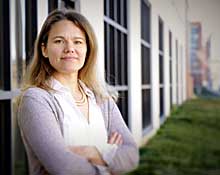Studying the Environment’s Impact on Health
By Joe Rada
 Julia Gohlke is studying the health effects of climate change in urban and rural areas, including how ambient temperatures affect mortality and premature births.When Julia Gohlke, Ph.D., moved to Alabama in 2010, she found herself on the front lines of a disaster. The Deepwater Horizon oil spill had just occurred, creating a primary health concern for the Gulf Coast states. So Gohlke, an assistant professor in the School of Public Health’s Department of Environmental Health Sciences, jumped right in to help with spill-related research. “I worked with a fisheries group to review the process used to determine seafood safety,” she says, glad for the chance to contribute something positive during that unfortunate situation.
Julia Gohlke is studying the health effects of climate change in urban and rural areas, including how ambient temperatures affect mortality and premature births.When Julia Gohlke, Ph.D., moved to Alabama in 2010, she found herself on the front lines of a disaster. The Deepwater Horizon oil spill had just occurred, creating a primary health concern for the Gulf Coast states. So Gohlke, an assistant professor in the School of Public Health’s Department of Environmental Health Sciences, jumped right in to help with spill-related research. “I worked with a fisheries group to review the process used to determine seafood safety,” she says, glad for the chance to contribute something positive during that unfortunate situation.
Around that time she also met Fulbright fellow and UAB doctoral student Dzigbodi Doke from Ghana in West Africa, and the pair put their firsthand knowledge of the oil disaster to good use. “We conducted a seminar in Ghana on lessons learned from the spill,” Gohlke says. “A large group of stakeholders there is interested in the burgeoning deepwater oil industry in the Gulf of Guinea. That opportunity led to a collaboration with several Ghanaian researchers interested in environmental issues.”
Climate Change and Children
But there is more to environmental health sciences than planning for and responding to disasters. At UAB, Gohlke has pursued two research projects that focus on the human health effects of climate change, particularly on children.
One project involves the health implications of energy use and climate change in urban and rural populations. She evaluates residents’ exposure to ambient temperatures in cities like Birmingham and in the countryside, looking at potential effects on mortality and premature birth.
The goal is to “evaluate if there are differences in vulnerability to heat waves in urban versus rural settings,” Gohlke explains. Another aim is to establish collaborations with local community groups such as the Friends of West End in Birmingham and the West Central Alabama Community Health Improvement League in order to identify environmental health priorities, she adds. In summer 2012, Gohlke is working with the two community groups on a separate pilot study that will track body composition relative to heat and time spent outdoors.
It Starts With the Fleas
Gohlke also investigates alternative methods of determining the effect of environmental changes on growth, a field of study known as developmental toxicity. In this case, instead of studying people, she’s looking at daphnia—a species of tiny, semitransparent, freshwater crustaceans also called “water fleas.” She examines how the surrounding environment affects lifespan, energy metabolism, and lipid storage in the daphnia as a model for how the same factors might affect human health.
Finding new model systems is important, Gohlke notes, “since current methods used to identify safe levels of exposure rely on acute exposures in controlled laboratory settings,” and those results don’t always match up with real-world experience.
Hot Topics
Since Gohlke works in the hotly contested world of climate-change research, does she ever take grief from skeptics? “Not at all,” she says. “My work focuses on environmental health issues that are of concern now”—how extreme heat is particularly common in urban environments, for example. “In general, public health concerns that are modified by environmental change and energy choices are highly relevant today, while much of the skepticism around climate science has to do with the ability to predict climate far into the future.”
Interest in environmental health science is growing. At UAB, “I teach a course on assessing and managing environmental risks,” Gohlke says. “It provides an overview of environmental policy using examples from local, federal, and international bodies. We focus on demonstrating how toxicology and exposure measurements are used in environmental risk assessment and management. The course primarily draws graduate students from public health and from engineering who are interested in how health research is used to establish environmental policy.”
Local Exposure
Gohlke grew up in West Virginia, studied biology at the University of Michigan and environmental health at the University of Washington, and has worked with the Environmental Protection Agency, World Health Organization, National Institute of Environmental Health Sciences, and other research entities. “Science was always my favorite subject,” she says. “I knew in high school that I wanted a career in scientific research. At the University of Michigan, while doing undergraduate research looking at two fish species that interbreed in polluted but not pristine habitats, I became interested in how natural and constructed environments affect human health.”
The Business of Health
If time and funding allow, Gohlke hopes to add another subject to her research: “I would love to delve more into economic theory,” she says. “Many people consider environmental issues to be in opposition to economics and many disagree, yet there doesn’t seem to be consistent research yet to support either view.”
Meanwhile, Gohlke says she is focused on her climate and health studies. “Right now, my primary goal is to develop testable, biology-focused research questions.”